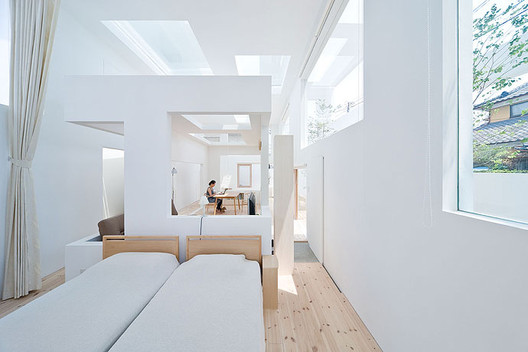Relational Logics – Theory Class

- HOUSE N, Sou Fujimoto Architects
Fujimoto’s house allows us to see how nature acts as a tool to create an interaction between the public and the private. In this way, it creates an open space that is protected at the same time. The trees have space inside the house, and are a fundamental part of its concept. An atmospheric interaction is created where the tree configures architecture, nature determines parameters and values that the architect takes advantage of. It is interesting to see how nature modifies the aspect of the house, it is mutable architecture because it transforms the dynamics inside the house, according to the weather and seasons. Nature changes along with the appearance of the house. In Japan, nature is perceived as an object of contemplation, which is the reason why when including it in the urban spaces through housing is a good way to give an external appearance to the comfort of the home.
Interaction is the main concept of the house, not between the public and private space but the location of the elements inside. It shows how the privatest space is the living room, located in the middle of the house, because culturally is space to share with the family.
The question then is, how much privacy has a person on this house ?, since the limits are just high walls, it gives us a vulnerability sense, where is not known if it is in or out.
Besides, there is a disagreement, because perhaps the N house has not communication with the houses around aesthetics. It’s minimalist look does not fit well with the culture. floating in the streets, out of context.
- The Habitats of Saint Jerome, Alison Smithson
Alison Smithson in her text, speaks about Saint Jerome and his habitats in which he was represented in the paintings over time, showing not only the stages of their life through allegories in painting, but also about political and religious changes at the time.
The first space in which Saint Jerome is represented is defined as nature, which is shown as an allegory of creativity. a space for creation, writing.
The second place is the desert, a place for finding himself, pray, and answer questions, but also a space of freedom where the distractions are away, only the landscape.
The last place that was depicted, is the cave, which appears as a representation of union of the two previous places, where they can create but also questioned. Besides this religion appears, because the cave is associated with the Nativity, live animals appear.
Globally, in the three paintings, spaces were designed as a machine, in which each object had a role, but also has symbolism, to represent the state of work on which Jerome was in the stages of his life. Nature appears as an allegory of freedom, the escape and the emergence of a new green consciousness, in which we talk about a better use of resources. the common thread between the three spaces is that they were all quiet atmosphere, and that nature was present, creating a link between academic life and nature.
Advanced Architecture Concepts: Relational Logics is a project of IaaC, Institute for Advanced Architecture of Catalonia developed at Master of Advanced Architecture in 2015/16 by:
Student:
Lina Salamanca
Tutor:
Ricardo Devesa